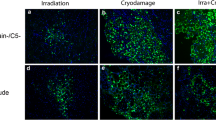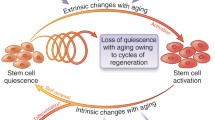Abstract
The ability of very old animals to make new muscle after injury remains controversial. This issue has major implications for the regenerative potential of damaged geriatric human muscle, to age-related loss of muscle mass (sarcopenia) and to the proposed need for muscle stem cell therapy for the aged. To further address issues of inherent myogenic capacity and the role of host systemic factors in new muscle formation, whole muscle grafts were transplanted between geriatric (aged 27–29 months) and young (3 months) C57Bl/6J mice and compared with autografts in geriatric and young mice. Grafts were sampled at 5 and 10 days for histological analysis. Inflammation and formation of new myotubes was strikingly impaired at 5 days in the geriatric muscle autografts. However, there was a strong inflammatory response by the geriatric hosts to young muscle grafts and geriatric muscles provoked an inflammatory response by young hosts at 5 days. At 10 days, extensive myotube formation in geriatric muscle autografts (equivalent to that seen in young autografts and both other groups) confirmed excellent intrinsic capacity of myogenic (stem) cells to proliferate and fuse. The key conclusion is that a weaker chemotactic stimulus by damaged geriatric muscle, combined with a reduced inflammatory response of old hosts, results in delayed inflammation in geriatric muscle autografts. This delay is transient. Once inflammation occurs, myogenesis can proceed. The presence of well developed myotubes in old muscle autografts at 10 days confirms a very good inherent myogenic response of geriatric skeletal muscle.




Similar content being viewed by others
References
Baker BA, Hollander MS, Mercer RR, Kashon ML, Cutlip RG (2008) Adaptive stretch-shortening contractions: diminished regenerative capacity with aging. Appl Physiol Nutr Metab 33:1181–1191
Borisov AB, Dedkov EI, Carlson BM (2005a) Abortive myogenesis in denervated skeletal muscle: differentiative properties of satellite cells, their migration, and block of terminal differentiation. Anat Embryol (Berl) 209:269–279
Borisov AB, Dedkov EI, Carlson BM (2005b) Differentiation of activated satellite cells in denervated muscle following single fusions in situ and in cell culture. Histochem Cell Biol 124:13–23
Brack A, Rando TA (2007) Intrinsic changes and extrinsic influences of myogenic stem cell function during aging. Stem Cell Rev 3(12):226–237
Brack AS, Conboy MJ, Roy S, Lee M, Kuo CJ, Keller C, Rando TA (2007) Increased Wnt signaling during aging alters muscle stem cell fate and increases fibrosis. Science 317:807–810
Brack A, Conboy IM, Conboy MJ, Shen J, Rando TA (2008) A temporal switch from Notch to Wnt signalling in muscle stem cells is necessary for normal adult myogenesis. Cell Stem Cell 2:50–59
Brooks SV, Faulkner JA (1988) Contractile properties of skeletal muscle from young, adult and aged mice. J Physiol 404:71–82
Carlson BM (1995) Factors influencing the repair and adaption of muscles in aged individuals: satellite cells and innervation. J Gerontol 50A:96–100
Carlson BM, Faulkner JA (1989) Muscle transplantation between young and old rats: age of host determines recovery. Am J Physiol 256:1262–1266
Carlson BM, Dedkov EI, Borisov AB, Faulkner JA (2001) Skeletal muscle regeneration in very old rats. J Gerontol 56A:B1–B10
Collins CA, Zammit PS, Ruiz AP, Morgan JE, Partridge TA (2007) A population of myogenic stem cells that survives skeletal muscle aging. Stem Cells 25:885–894
Conboy IM (2003) Notch mediated restoration of regenerative potential to aged muscle. Science 302:1577–1757
Conboy IM (2005) Rejuvination of aged progenitor cells by exposure to a young systemic environment. Nature 433:760–764
Dedkov EI, Kostrominova TY, Borisov AB, Carlson BM (2003) MyoD and myogenin protein expression in skeletal muscles of senile rats. Cell Tissue Res 311:401–416
Desaki J (2008) Regeneration of muscle fibers in the extensor digitorum longus muscle of the aged rat. J Electron Microsc (Tokyo) 57:59–66
Edstrom E, Ulfhake B (2005) Sarcopenia is not due to lack of regenerative drive in senescent skeletal muscle. Aging Cell 4:65–77
Edstrom E, Altun M, Bergman E, Johnson H, Kullberg S, Ramirez-Leon V, Ulfhake B (2007) Factors contributing to neuromuscular impairment and sarcopenia during aging. Physiol Behav 92:129–135
Frontera WR, Hughes VA, Fielding RA, Fiatarone MA, Evans WJ, Roubenoff R (2000) Aging of skeletal muscle: a 12-yr longitudinal study. J Appl Physiol 88:1321–1326
Gopinath SD, Rando TA (2008) Stem cell review series: aging of the skeletal muscle stem cell niche. Aging Cell 7:590–598
Grounds MD (1998) Age-associated changes in the response of skeletal muscle cells to exercise and regeneration. Ann N Y Acad Sci 854:78–91
Grounds M, Relaix F (2009) Myogenic Precursor Cells. Chapter 2 in Section I—Scientific basis of muscle disease. In: Hilton-Jones D, Griggs R, Bushby K, Karpati G (eds) Disorders of Voluntary Muscles. Cambridge University Press, Cambridge
Grounds MD, Davies M, Torrisi J, Shavlakadze T, White J, Hodgetts SI (2005) Silencing TNFα activity using Remicade® or Enbrel® blocks inflammation in whole muscle grafts: an in vivo bioassay to assess the efficacy of anti-cytokine drugs in mice. Cell Tissue Res 320:509–515
Kaminska A, Fidzianska A, Schulze G, Coper H, Ossowska K, Wolfarth S, Hausmanowa-Petrusewicz I (1998) Ultrastructural changes in the skeletal muscle of senile rats with significant age-dependent motor deficits. Basic Appl Myol 8:185–190
Lynch GS, Shavlakadze T, Grounds MD (2005) Strategies to reduce age-related skeletal muscle wasting. In: Rattan S (ed) Ageing Interventions and Therapies. World Scientific Publishers, Singapore, pp 63–84
Mouly V, Aamiri A, Bigot A, Cooper RN, Di Donna S, Furling D, Gidaro T, Jacquemin V, Mamchaoui K, Negroni E, Perie S, Renault V, Silva-Barbosa SD, Butler-Browne GS (2005) The mitotic clock in skeletal muscle regeneration, disease and cell mediated gene therapy. Acta Physiol Scand 184:3–15
Pagala MK, Ravindran K, Namba T, Grob D (1998) Skeletal muscle fatigue and physical endurance of young and old mice. Muscle Nerve 21:1729–1739
Radley HG, Davies MJ, Grounds MD (2008) Reduced muscle necrosis and long-term benefits in dystrophic mdx mice after cV1q (blockade of TNF) treatment. Neuromuscul Disord 18:227–238
Renault V, Thornell LE, Eriksson PO, Butler-Browne G, Mouly V (2002) Regenerative potential of human skeletal muscle during aging. Aging Cell 1:132–139
Roberts P, McGeachie JK (1992) The influence of revascularisation, vasoactive drugs and exercise on the regeneration of skeletal muscle, with particular reference to muscle transplantation. BAM 2:5–16
Roberts P, McGeachie JK, Grounds MD, Smith ER (1989) Initiation and duration of myogenesis in transplants of intact skeletal muscles: an autoradiographic study in mice. Anat Rec 224:1–6
Roberts P, McGeachie JK, Grounds MD (1997) The host environment determines strain-specific differences in the timing of skeletal muscle regeneration: cross-transplantation studies between SJL/J and BALB/c mice. J Anat 191:585–594
Robertson TA, Grounds MD, Papadimitriou JM (1992) Elucidation of aspects of murine skeletal muscle regeneration using local and whole body irradiation. J Anat 181:265–276
Sadeh M (1988) Effects of aging on skeletal muscle regeneration. J Neurol Sci 87:67–74
Shavlakadze T, Grounds MD (2003) Therapeutic interventions for age-related muscle wasting: importance of innervation and exercise for preventing sarcopenia. In: Rattan S (ed) Modulating aging and longevity, Chap 9. Kluwer Academic publisher, The Netherlands, pp 139–166
Shavlakadze T, Davies M, White JD, Grounds MD (2004) Early regeneration of whole skeletal muscle grafts is unaffected by overexpression of IGF-1 in MLC/mIGF-1 transgenic mice. J Histochem Cytochem 52:873–883
Shavlakadze T, Boswell JM, Burt DW, Asante EA, Tomas FM, Davies MJ, White JD, Grounds MD, Goddard C (2006) Rskalpha-actin/hIGF-1 transgenic mice with increased IGF-I in skeletal muscle and blood: impact on regeneration, denervation and muscular dystrophy. Growth Horm IGF Res 16:157–173
Smythe GM, Shavlakadze T, Roberts P, Davies MJ, McGeachie JK, Grounds MD (2008) Age influences the early events of skeletal muscle regeneration: studies of whole muscle grafts transplanted between young (8 weeks) and old (13–21 months) mice. Exp Gerontol 43:550–562
Snijders T, Verdijk LB, van Loon LJ (2009) The impact of sarcopenia and exercise training on skeletal muscle satellite cells. Ageing Res Rev 8:328–338
White JD, Scaffidi A, Davies M, McGeachie J, Rudnicki MA, Grounds MD (2000) Myotube formation is delayed but not prevented in MyoD-deficient skeletal muscle: studies in regenerating whole muscle grafts of adult mice. J Histochem Cytochem 48:1531–1544
White JD, Collins R, Vermeulen R, Davies M, Grounds MD (2002) The role of p53 in vivo during skeletal muscle post-natal development and regeneration: studies in p53 knockout mice. Int J Dev Biol 46:577–582
Acknowledgments
This study was supported by funding from the National Health and Medical Research Council (Australia). We thank Kirsten Maley for carrying out immunostaining.
Author information
Authors and Affiliations
Corresponding author
Rights and permissions
About this article
Cite this article
Shavlakadze, T., McGeachie, J. & Grounds, M.D. Delayed but excellent myogenic stem cell response of regenerating geriatric skeletal muscles in mice. Biogerontology 11, 363–376 (2010). https://doi.org/10.1007/s10522-009-9260-0
Received:
Accepted:
Published:
Issue Date:
DOI: https://doi.org/10.1007/s10522-009-9260-0




